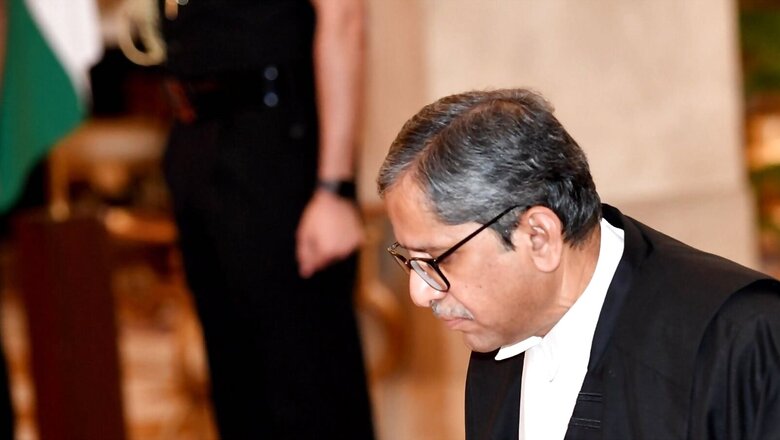
views
Chief Justice of India (CJI) N V Ramana on Saturday termed governments as the “biggest litigants”, accounting for nearly 50 per cent of pending cases, and said the “docket explosion” is due to non-performance of various wings of the executive and the legislature not realising its full potential.
While dealing with the reasons for docket explosion, the CJI referred to growing number of contempt cases arising out of defiance of judicial orders by the executive and said that “deliberate inactions by governments, despite judicial pronouncements, are not good for the health of democracy”.
Speaking at the Joint Conference of Chief Ministers and Chief Justices of High Courts, inaugurated by Prime Minister Narendra Modi, CJI Ramana flagged key problems faced by the Indian judiciary such as pendency, vacancies, dwindling judge-population ratio and the lack of infrastructure in courts.
Reminding the State’s three organs — executive, legislature and judiciary — to be “mindful of the ‘Lakshman Rekha’ while discharging their duties”, he assured governments that “the judiciary would never come in the way of governance, if it is in accordance with law”. “We share your anxiety and concern regarding the welfare of the people,” Justice Ramana said.
Dwelling further, he said all constitutional functionaries abide by the constitutional mandate as the Constitution provides for separation of powers between the three organs, clearly outlining their sphere of functioning, and delineating their powers and responsibilities.
“It is a well acknowledged fact that governments are the biggest litigants, accounting for nearly 50 per cent of the cases,” the CJI said and gave illustrations as to how inactions of various wings of the executive forces citizens to approach courts.
“Based on these examples, one can safely summarise that, often, litigation is triggered because of two major reasons. One is, non-performance by the various wings of the executive. Second is, the legislature not realising its full potential,” he said.
The decisions of courts are not implemented by governments for years together and the result is that contempt petitions are a new category of burden on courts, a direct result of the defiance by governments, the CJI said.
On the issue of vacancies, he said that as on today, out of 1,104 sanctioned posts of high court judges, there are 388 vacancies. “From day one, it has been my endeavour to fill judicial vacancies. We have made 180 recommendations for appointments in various high courts during the last year. Out of this, 126 appointments have been made,” he said and thanked the Centre for clearing names.
“However, 50 proposals are still awaiting approval by the Government of India. The high courts have sent around 100 names to the Government of India. They are yet to reach us. The data reveals the earnest efforts being made by the judiciary to fill the vacancies,” he said.
The CJI also urged chief ministers to “extend wholehearted co-operation to the chief justices” in their endeavour to strengthen the district judiciary.
He said in 2016, the sanctioned strength of judicial officers in the country was 20,811 and now, it is 24,112, which is an increase of 16 per cent in six years. “On the other hand, in the corresponding period, pendency in district courts has gone up from 2.65 crore to 4.11 crore, which is an increase of 54.64 per cent. This data shows how inadequate the increase in the sanctioned strength is,” he said and termed the judge-to-population ratio of 20 judges per 10 lakh as “very alarming”.
The judiciary is also confronted with the issue of the executive willingly transferring the burden of decision making to it despite the fact that the policy making is not in its domain, he said, adding that the courts cannot say ‘no’ to citizens. Justice Ramana also flagged lack of debates by legislatures in clearing laws and said at times, ambiguities in legislations also add to existing legal issues.
“The legislature is expected to solicit the views of the public and debate the bills, clause by clause, threadbare, before enacting a law. When I expressed concern about the passing of laws without much legislative scrutiny on August 15 last year, I was misunderstood by some quarters. “Let there be no doubt. I have the highest regard for the legislature and the elected representatives,” he said and quoted Lok Sabha Speaker Om Birla who had reportedly favoured debates on passage of laws.
Justice Ramana talked about the rising number of frivolous litigations and said, “For example, the well-meaning concept of public interest litigation is at times turning into personal interest litigation.” He said, “Indianisation of the justice delivery system” is needed by moulding the system to suit the needs and sensibilities of the common Indian population.
He advocated the need of setting up of the National Judicial Infrastructure Authority and the State Judicial Infrastructure Authorities in the lines of NALSA and SLSAs to meet the growing need of infrastructures in courts.
“Let me make it very clear. This is not about funds. I must acknowledge that the Union Government has been making reasonable budgetary allocation… The time has come to move on from the present ad-hoc committees to a more streamlined, accountable and organised structure, he said, adding that the proposal was not “aimed at usurping powers of any”.
The 11th Chief Justices-Chief Ministers’ conference was held after a gap of six years following the Saturday’s 39th chief justices’ conference held with an “aim and object to discuss and identify the problems that are affecting the administration of justice”.
Read all the Latest India News here




















Comments
0 comment